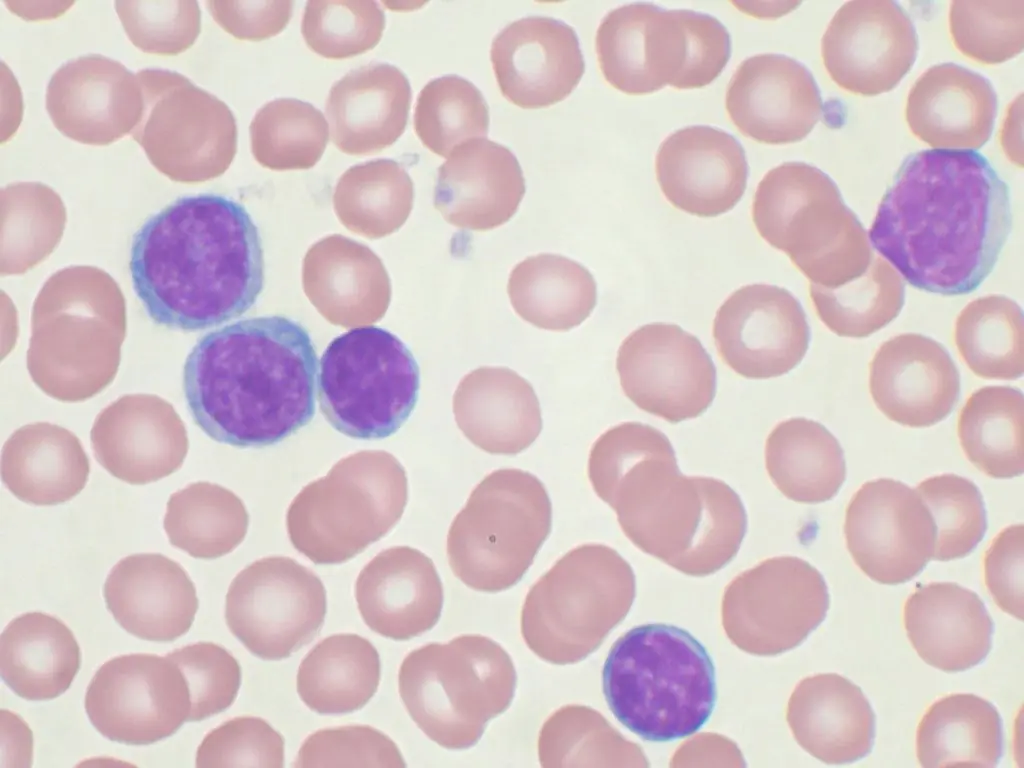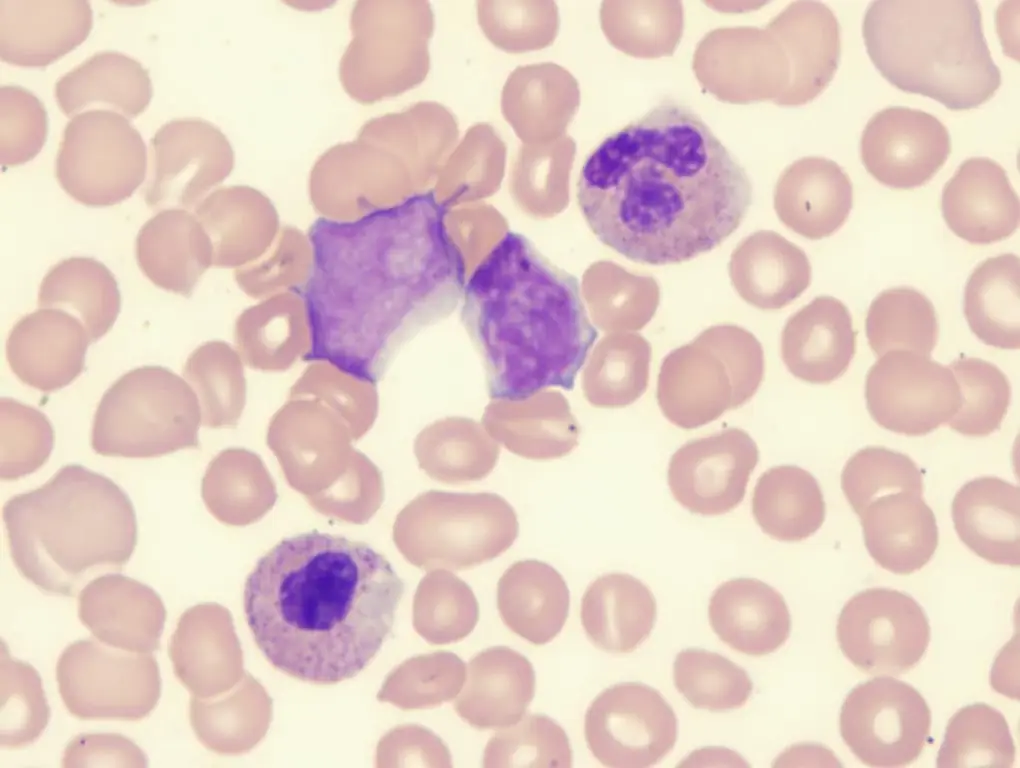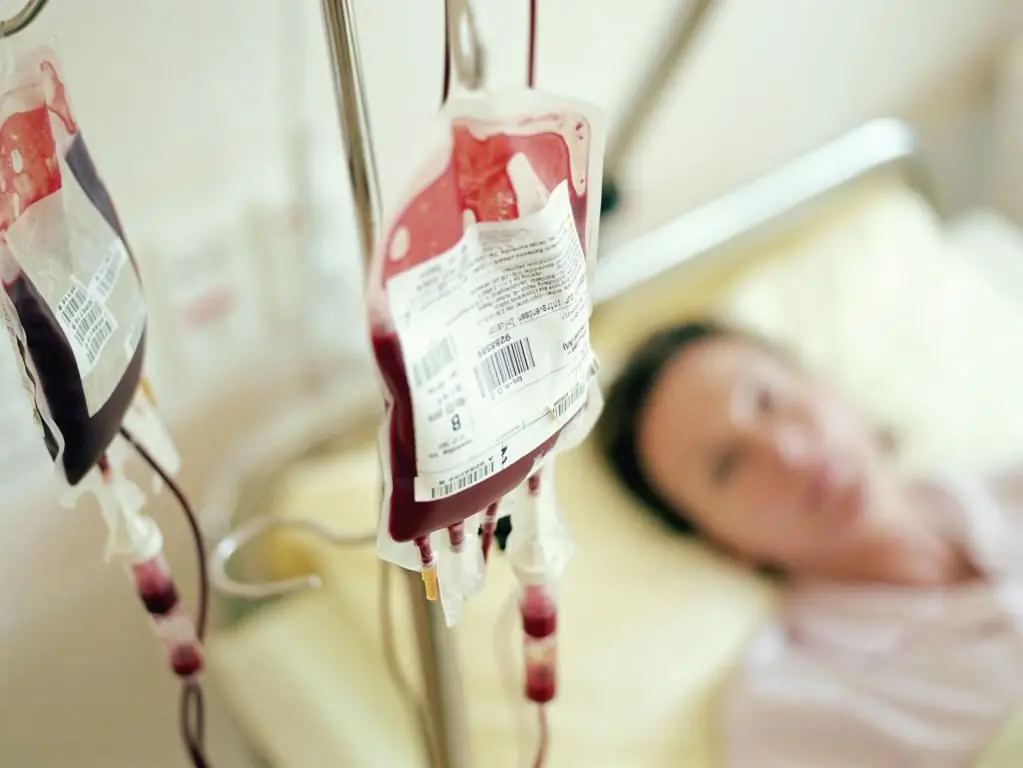- Author Curtis Blomfield [email protected].
- Public 2023-12-16 20:44.
- Last modified 2025-01-23 17:01.
Blood diseases make up a large and diverse group of syndromes that form in violation of the qualitative and quantitative composition of the blood. All of them are systematized based on the damage to any component of the blood. Hematological diseases are divided into three main groups:
- pathologies characterized by a decrease in hemoglobin levels;
- hemoblastosis;
- hemostasiopathies.
Refractory anemia is one of the varieties of anemia, characterized by a violation of the maturation of red germ cells.
Myelodysplastic syndrome - what is it?

A group of diseases and conditions with a violation of the formation of erythrocytes, monocytes, platelets, granulocytes in myeloid tissue (myeloid hematopoiesis) with a high probability of developing a tumorlesions of the hematopoietic system in medicine are called myelodysplastic syndrome (MDS).
The clinical signs in this case are the same as in anemia, a condition characterized by a decrease in the level of neutrophilic granulocytes in the blood and thrombocytopenia. The disease is more common in people over 60 years old, and men are more susceptible to it than women. However, recently there has been a "rejuvenation" of the disease. Hematologists believe that the reason lies in the deterioration of the environmental situation.
One of the diseases of the group of myelodysplastic syndrome is refractory anemia. This pathology, like all other combined MDS, refers to hematological diseases characterized by cytopenia (a decrease in the level of a certain type of cell in the blood) and pathological changes in the bone marrow.
Classification of myelodysplastic syndrome
Some changes were made to the international classification of diseases, which also affected hematological diseases. The systematization is similar to that proposed earlier by WHO, but differs from FAB in the number of options for defining diseases:
- D46.0 - refractory anemia without sideroblasts.
- D46.1 - RA with ringed sideroblasts. Immature blood cells are not found in the blood.
- D46.2 - refractory anemia with excess blasts 1. In the blood test, cytopenia, excess monocytes, Auer bodies are absent.
- D46.3 - refractory anemia (RA) with many blasts with transformation.
- D46.4 - RA unspecified.
- D46.5 - refractory cytopenia with multilineagedysplasia.
- D46.6 - myelodysplastic syndrome associated with 5q deletion.
- D46.7 - other myelodysplastic syndromes.
- D46.9 - myelodysplastic syndrome, unspecified.
Features of refractory anemia
Refractorius in Latin means "unreceptive", "intractable". The disease belongs to hematological and is characterized by a violation of the development of an erythrocyte germ in the blood produced by the bone marrow. In the syndrome of refractory anemia, the content of erythrocytes in the blood first decreases, and then the rest of the cells, the organ of the hematopoietic system responsible for hematopoiesis is affected.
The main danger of pathology lies in the fact that it is not amenable to treatment based on the use of iron-containing drugs. This type of anemia is often almost asymptomatic and is detected in the diagnosis of other pathologies. The disease progresses rapidly and leads to the development of acute leukemia.
Refractory anemia with excess blasts

Based on statistics, there are about 1,015,000 people with a similar diagnosis. The disease is most common in men aged 75-80 years, and in women aged 73-79 years. Pathology is divided into two types:
- RAIB-1 - is characterized by cytopenia, an increase in the number of monocytes in the blood. Rod-shaped red protein inclusions in the cytoplasm of monocytes (Auer bodies) are not detected. Bone marrow shows dysplasia of one cell line, blasts (immature blood cells)about 5-19%.
- RAIB with transformation - blood test shows an increased content of monocytes, Auer bodies are detected. The content of blasts is about 30%. In the bone marrow, dysplasias of several cell lines are found at once. This pattern contributes to the development of acute myeloid leukemia.
The mortality rate from this pathology is about 11%.
Causes of pathology
The exact causes of the development of the disease have not yet been identified. There are two types of the syndrome, and risk factors have been established for each of them.
Primary (ideopathic) is detected in almost 90% of cases. Risk factors:
- Smoking.
- Exceeded level of radiation.
- Residing in an unfavorable ecological zone.
- Regular inhalation of gasoline vapors, organic solvents, pesticides.
- Recklinghausen's congenital neurofibromatosis (development of tumors from the nervous tissue).
- Fanconi hereditary anemia.
- Down syndrome.
Secondary type of refractory anemia (MDS) occurs in 20% of cases, can develop at any age. Main reasons for development:
- Chemotherapy or radiotherapy.
- Long-term use of certain groups of drugs: cyclophosphates, anthracyclines, topoisomerase inhibitors, podophyllotoxins.
The secondary variant is characterized by high resistance to therapy and a high probability of developing acute leukemia and, as a result, an unfavorable prognosis.
How to identify the disease?

Often, the pathology develops without any symptoms, which makes it difficult to start treatment at an early stage and in mild forms. As a rule, severe refractory anemia is diagnosed during a routine examination of the patient.
But it is still possible to detect the disease in the early stages. Its first signs have much in common with the manifestations that occur with liver pathologies, autoimmune diseases and any other anemia. These include:
- Paleness, transparency of the skin, especially on the face.
- Excessive thickening of the stratum corneum of the epidermis on the elbows and knees.
- The formation of hematomas that take a long time to pass.
- Permanent cracks in the oral mucosa.
- Brittle nails.
- Change in smell and taste: addiction to strong odors, desire to eat earth, chalk.
- Fatigue.
- Frequent SARS with severe course.
If you experience these symptoms, you should consult a doctor.
Clinical manifestations of severe pathology

The clinical picture of anemia consists of two phases: chronic hemosuppression and severe (final) stage.
The following manifestations are observed in hemodepression:
- Significant increase in temperature, fever.
- Sharp breakdown.
- General feeling unwell.
- Weight loss.
- Increased internal organs: spleen, liver.
- Swollen and sore lymph nodes.
Such conditions are protracted, with periodsremission.
The symptoms of severe refractory anemia (myelodysplastic syndrome) are the same as those of acute leukemia. The disease develops rapidly. One of its features is the detection of blasts in a blood test. The disease is accompanied by the following symptoms:
- Hematomas, even with minor bruises.
- Bleeding gums.
- Gingivitis.
- Binocular displacement of the eyeball.
- Persistent repeated inflammatory processes in the nasopharynx.
- Suppuration of scratches, small wounds.
- Pain in the spine.
In elderly patients, secondary diseases occur, the cardiovascular system is more often affected. Patients experience pain when walking in the lower extremities.
Diagnostic measures

At the first suspicious symptoms, you should consult a doctor. The diagnosis of "myelodysplastic syndrome" or "refractory anemia with an excess of blasts" is made only after passing a series of laboratory tests. They include:
- Clinical analysis of peripheral blood.
- Cytological studies of bone marrow aspirate.
- Trepanobiopsy is the taking of biomaterial from the bone marrow by puncturing the tibia.
- Cytogenetic test. Testing for chromosomal abnormalities is a must.
Depending on the clinical picture of the disease, additional diagnostic measures may be prescribed:
- Ultrasound of the abdomen.
- Esophagogastroduodenoscopy of the gastrointestinal tract.
- Analysis for specific tumor markers.
Therapy Methods

The choice of treatment for refractory anemia is determined by the severity of clinical manifestations and the results of laboratory tests. Treatment regimens are quite complex and are determined by the doctor. Patients with few blasts are at low risk. They receive substitution and maintenance treatment and can lead an almost normal life. The approximate treatment regimen is as follows:
- In stationary conditions, observation is carried out. The main task: maintaining a normal level of hemoglobin and preventing the development of an anemic syndrome. The patient is receiving a transfusion of donated red blood cells.
- In severe anemia, drugs are prescribed that help restore iron-containing protein: Exjade, Desferol.
- To prevent immune aggression against the bone marrow, "Lenalidomide" with antimonocytic globulin and "Cyclosporine" is used.
- When infectious diseases are detected, antibacterial drugs are prescribed depending on the pathogen and its resistance.
- If necessary, perform a bone marrow transplant.
Forecasting
The prognosis of refractory anemia (myelodysplastic syndrome) depends on the clinical picture, the body's response to therapy, and the timeliness of seeking medical help. The outcome of the disease is determined by the severitydeficiency of certain cells, the presence and profile of chromosomal abnormalities, the number of blasts and their tendency to develop in the blood and bone marrow.
Prevention

In view of the fact that the essence, circumstances and mechanisms of the development of pathology have not yet been fully investigated, it is almost impossible to name effective preventive methods. Doctors advise adherence to the following he alth recommendations:
- Eat a well-balanced diet.
- Include foods high in iron in your diet.
- Stay outdoors more often.
- Give up bad habits, in particular smoking.
- Use protective equipment when working with pesticides or organic solvents.
Refractory anemia is a dangerous hematological disease that turns into oncology. To avoid severe stages of the disease and serious consequences, it is necessary to regularly conduct a routine examination. If a pathology is detected, it is necessary to complete the course of therapy, for many patients this helped not only improve, but also prolong life.






